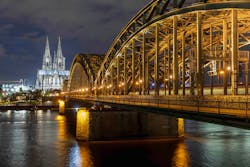If you want to understand the Internet of Things (IoT) ethos that is driving the general lighting industry, take a look at Cologne, Germany, where Signify has won a contract to replace and connect 85,000 outdoor lights from a number of vendors to the Internet. The goal is to enable intelligent control and to possibly support non-lighting smart city functions such as traffic and air monitoring.
Not long ago in such an announcement, Signify — formerly called Philips Lighting, still the world’s largest lighting company, and still using the Philips brand on products — would have heralded that 85,000 Philips luminaires were on their way to Germany’s fourth most populous city.
But this is lighting business 2020. Many and perhaps most of the lights won’t come from Signify. The project’s main contractor, utility RheinEnergie, is still determining the luminaire providers through a bidding process, a Signify spokesperson told LEDs Magazine. A small number of luminaires have already been connected in what will be a 15-year project that started in January 2019.
Regardless of the brands, the luminaires will all feature intelligent Philips components from Signify that help connect the luminaires to Signify’s Interact IoT control and data system. These components typically reside in a luminaire socket conforming to Zhaga standards. The circuitry helps monitor luminaire performance and supports programmable control of on/off and brightness levels, although not of color temperature.
“This makes planning of maintenance and repairs more efficient and provides RheinEnergie with information and data on the performance and status of the light points for analyses, reports, and evaluations,” Signify said.
“In Signify, we have found a partner whose system can help us to drastically reduce the energy usage for urban lighting and at the same time keep Cologne shining in the best light,” RheinEnergie network director Andreas Cerbe.
Interact also runs to a central command at Cologne’s police department, which can remotely turn on lights in certain areas of the city if need be, the Signify spokesperson told LEDs.
The 15-year project underscores the trend in which lighting companies are trying to morph into lighting-based information technology product and service providers. Long-lasting LED lights have obliterated the century-plus-old business model of selling bulbs, light fixtures, and their replacements, so lighting companies like Signify are seeking revenue from data and IT products and services that leverage the lighting infrastructure.
Signify is even helping to integrate data collected by the lights into RheinEnergie’s SAP business software, combining luminaire inventory data with RheinEnergie’s accounting and purchasing data.
The Zhaga sockets can also accommodate sensors to monitor things like air quality, road traffic, and noise, but none of the lights installed so far have deployed those features, the spokesperson said.
The Cologne project marks at least the fourth time in recent months that Signify has announced a move aimed at boosting the IoT aspect of its business.
Earlier this month, it introduced a snap-in module to help connect office luminaires to the Interact system. Last month, it added multisite capabilities to help retail chains manage far-flung stores from a central location, developing it with iconic British retailer Marks & Spencer. Late last year, it said it has deployed Interact lighting at a Pilkington Automotive warehouse in Germany.
Signify introduced Interact two years ago, and tailors it for different sectors such as cities, industry, office, retail, hospitality, sports, landmarks, and small and medium enterprises.
In some Interact cases, Signify provides the luminaires — at Pilkington, for instance, and at Japan’s Kobe Stadium, among others. But as Cologne demonstrates, it is also willing to come in first and foremost in a data and smart controls capacity.
For all the emphasis the company is putting on the IoT, not all of its jobs head in that direction. For example, the 580 rooftop luminaires that Signify is providing to India’s 110,000-seat Motera Stadium — the world’s largest cricket venue — do not connect to Interact.
MARK HALPER is a contributing editor for LEDs Magazine, and an energy, technology, and business journalist ([email protected]).






